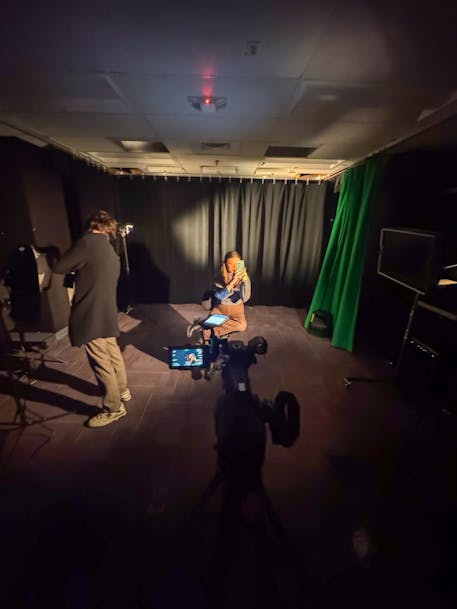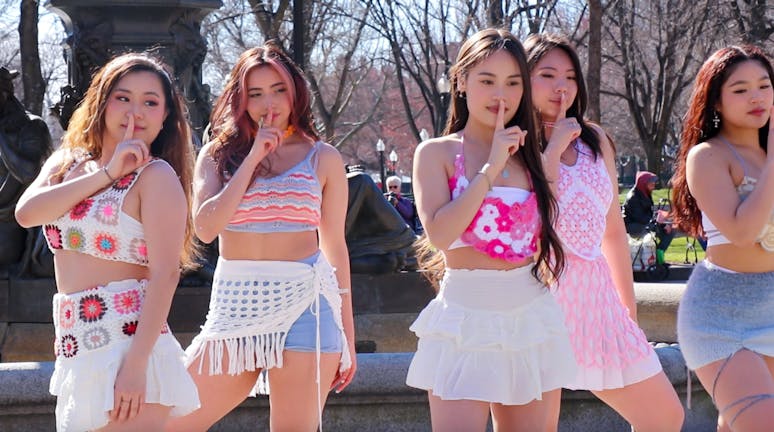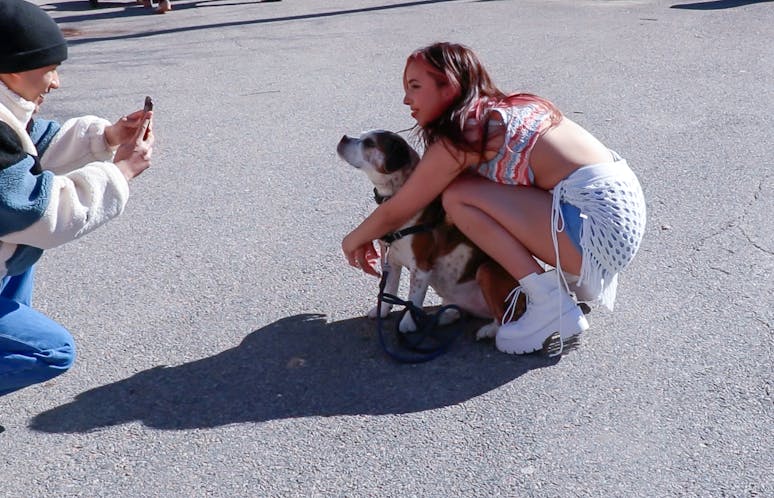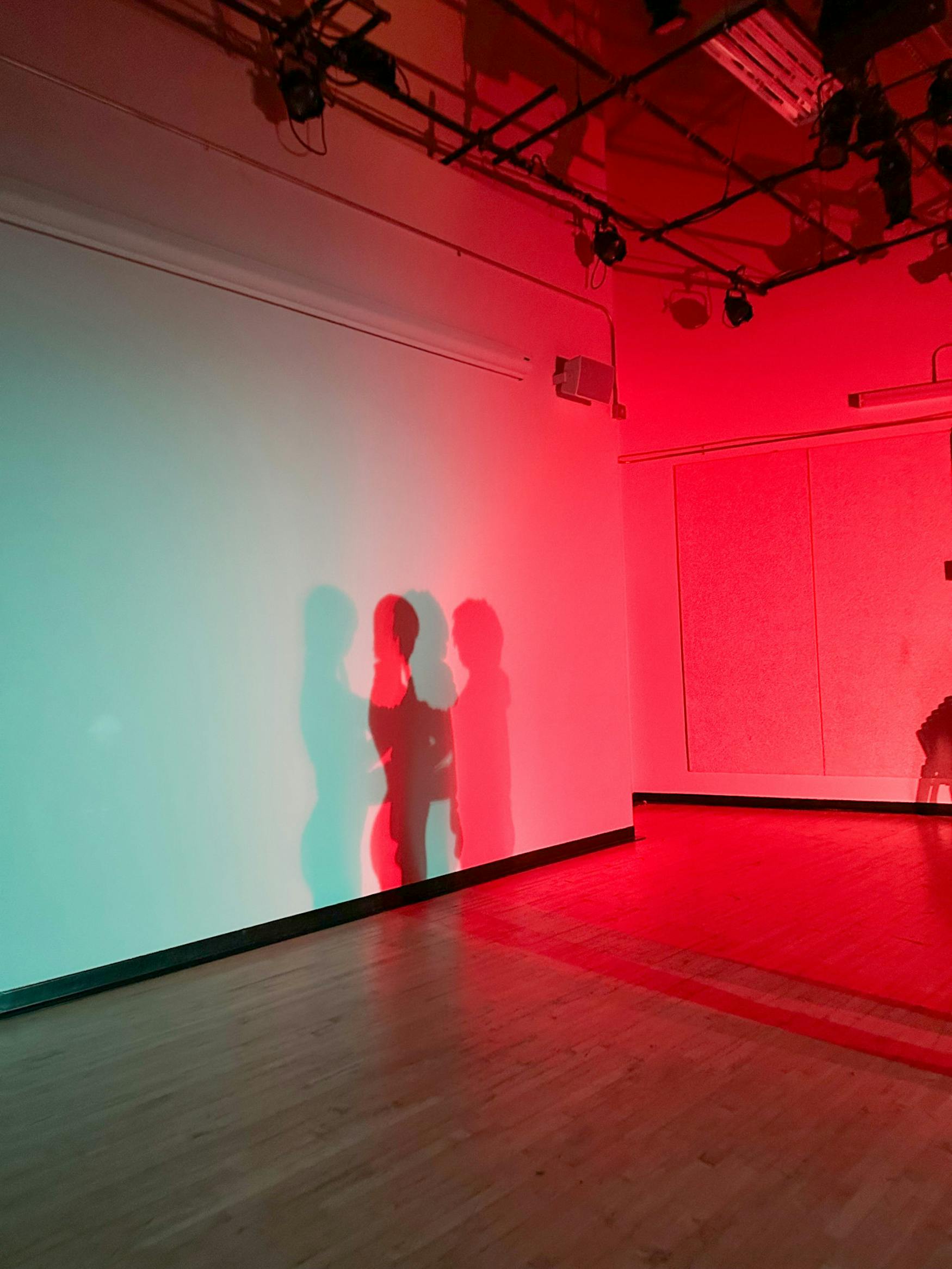Student filmmakers: Behind the scenes and on the screen
The Justice spotlights three student filmmakers and their most important projects thus far.
Many student filmmakers at Brandeis are studying Film, Television and Interactive Media alongside other subjects, balancing exams and extracurriculars with the lengthy process of screenwriting, equipment rentals, directing makeshift crews and more. Nevertheless, these creators are hard at work orchestrating all the moving parts to producing their video projects, from far-out fictional stories to incisive documentaries. The Justice heard from three dedicated student filmmakers who are working on realizing their creative visions through audiovisual mediums.
---
Leah Goldstein ’25 is majoring in FTIM, Psychology and Health, Science, Society, and Policy. During her time at Brandeis, she has been actively involved in the production of multiple film projects. Currently enrolled in the course FILM 110A: Film Production, she is now able to utilize the skills she’s accumulated over the years to the fullest extent. “After exploring media studies in previous semesters, I was excited to get hands-on experience with filmmaking again,” she told The Justice on Nov. 18.
Since enrolling in Brandeis’ FTIM program, Goldstein has produced several short films, and is currently working on her final project for her Film Production course. In this process, Goldstein and her group members — Nick Altman ’25 and Varun Challa ’26 — have been experimenting with different shots and lighting techniques. With this assignment, she’s able to play a hands-on role in the scriptwriting, producing and acting.
The process has been longer and more complex than anything else she’s done for the class, but Goldstein noted that this project has been the most significant one she’s been involved in over the course of her time at Brandeis.
Entitled “Those Final Moments,” the project is a mockumentary following two students who graduated from Brandeis two months ago and through a series of comedic events, reflect on how they embraced rebellion in their final year. In her final year at Brandeis herself, the project is meaningful to Goldstein on a personal level. “It’s both a humorous and poignant way for me to engage with the experience of nearing graduation and reminds me to savor my last year at Brandeis,” she explained.
The group filmed over four days, and Goldstein stated that she found the experience incredibly enjoyable. She recalled one of her favorite moments during shooting, “Sneakily filming in a Walgreens to capture some of our more spontaneous scenes.”
Goldstein shared that, through her film work at Brandeis, she’s learned the importance of maintaining the hobbies and passions that define who you are. She acknowledged how the hectic nature of college routines can make it difficult to keep consistent with childhood passions, and emphasized that, despite this, the film course has reignited her passion for filmmaking.
“It’s been an incredibly fulfilling experience, and I know that my love for film will stay with me long after I leave Brandeis,” she stated. The creative process, the collaboration with fellow students and the opportunity to contribute to the film scene at Brandeis have all been invaluable to her.

---
Brooke Lober ’26 is an FTIM major and Journalism minor and has worked on various film projects in their classes at Brandeis, namely FILM 120A: Cinematography. In this class, Lober made a mockumentary about a vampire who tries to fit in at college. Another short exercise for the class took them to different spots around campus as they scouted out locations and composed scenic shots.
In a Nov. 17 interview with The Justice, Lober reflected on the collaborative nature of the medium. They spoke about how they’ve helped friends with their projects and vice versa. They once worked with a friend on a short film about a boy who was obsessing over a dancer — so much so that he ended up killing her. Lober explained that that friend extended the cut into a full-fledged short film that was eventually submitted to a contest later that year.
After taking time to brainstorm ideas for the film, the two were able to innovate a unique approach to the cinematography. They noted that because it was such a low-stakes scenario, they felt free to experiment with a variety of different techniques.
“One of the coolest things I came up with during that project was filming the shadows of our actors dancing instead of just them dancing,” Lober explained. The decision to use shadows was made to create a mysterious atmosphere that accommodates the storyline. Most of the scenes were shot in a straightforward way, until the final dancing scene when the boy finally approaches the dancer. Through these filmic techniques, it is implied that the dancing scene didn’t really happen. The grim reality is that he ends up murdering the dancer in her studio.
“It was really awesome to be able to work with another person who loves filming as much as me because we spent a few hours making sure we could get the shadows in the right spots so they would merge into each other on the wall,” Lober reflected on the experience. They noted the value in being able to bounce ideas off of someone else in order to think more critically about your ideas.
They also emphasized the fact that making a film is simply a hard process: “It’s okay to not always know what you are doing. That’s just part of the learning process.” While it may be discouraging to have to try over and over again to get a shot right, Lober noted the importance of not giving up in capturing a scene the way it was imagined.
---
Emily Ren ’25 is majoring in anthropology and psychology with a minor in studio arts. Ren has worked on experimental and ethnographic documentaries in the past, as all of the film courses she’s taken have been focused on documentary-making.
Her favorite documentary she’s created is titled “I’ll be a Butterfly” The piece was a final project for ANTH 130a, a course on ethnographic documentary. As a dancer herself, Ren knew she wanted to produce a piece about dancing. Having been a fan of a Boston-based dance team called “Hush,” she decided to reach out to one of their members, Bela, who eventually became the main subject of the film.
On Nov. 18, Ren told The Justice that the entirety of the shooting process was collaborative — from audiovisual recording to interviewing. She discussed one of the most memorable moments in making the documentary with her class partner. The two documented the dance team filming a “dance in public” video at Boston Commons. “They had a cameraman filming them while we were simultaneously recording them for our documentary project,” she recalled.
While observing the performance, passersby would step in and out of frame, and one of them started heckling the dancers midway through the song. “I realized the courage it takes to dance in public spaces, and the unpredictable challenges [the dancers] have to face,” Ren stated.
While filming the dance group’s practice sessions, one of her main concerns was disturbing the rehearsal process and that the members might feel nervous about the presence of the camera. “We tried to keep some distance with them, offering them some comfortable space,” she explained.
For Ren, the whole experience was a chance to learn about how to ethically approach the real-life subjects in her documentary films. She shared that following “Hush” was a lesson in treating her interlocutors with respect — “to think about how they want to be portrayed, what side of them I want to portray and how to approach it through editing.”





Please note All comments are eligible for publication in The Justice.